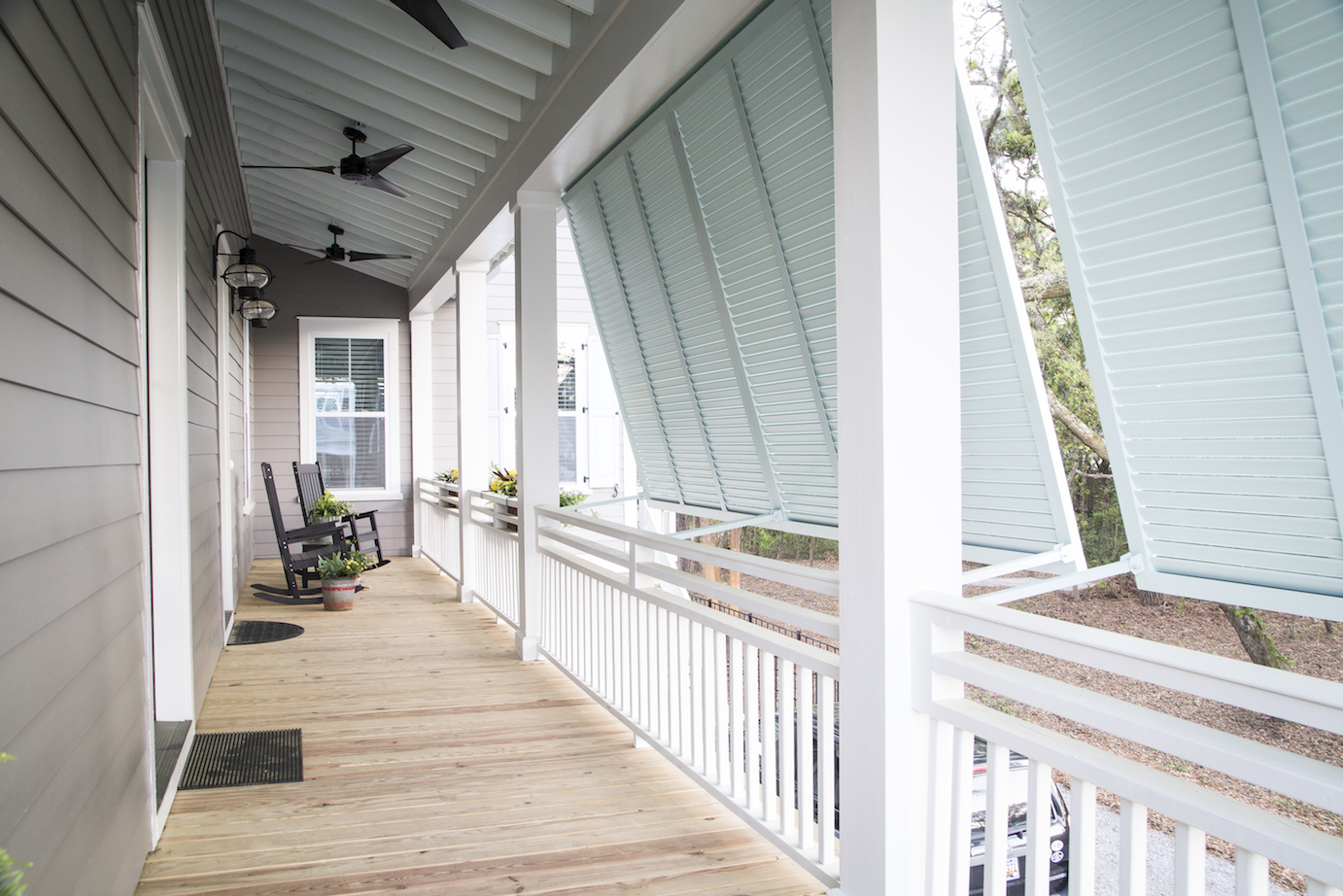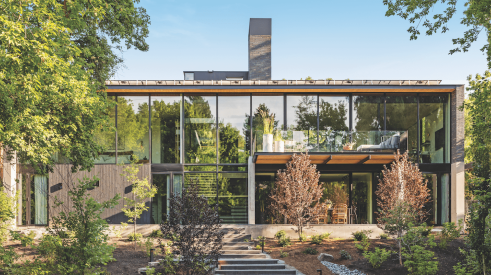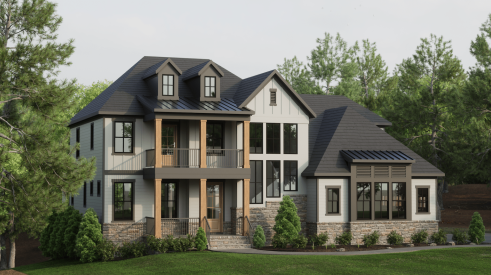Residential architecture and design speaks to homeowners and potential homeowners in a language that mirrors our times in everything from economic and political uncertainty to a desire for family connectedness to a need for ecological sustainability. For the past decade or so builders have seen demand for homes that are transitional, more pared down, less fussy. While this has occurred across all home design genres, modern farmhouse style has shown itself to be “the perfect in-between” for those who love tradition, history, and vintage yet still want homes that are fresh and contemporary, says Samantha Hart, group editor of Meredith Core Media’s luxury home portfolio, which includes the annual Modern Farmhouse Style.
Developers and builders are responding — and finding success — by offering homes built in the modern farmhouse vernacular. “If I’m building two types of houses in a current market, the farmhouse will be more popular,” says Bill Davidson, president of Davidson Communities and developer of The Oaks Farms, in San Juan Capistrano, Calif.
Modern Farmhouse: Not Your Grandma's Farmhouse Style
Most everyone can recognize a farmhouse. Think about the painting American Gothic by Grant Wood, says architect David Arkin, principal of Arkin Tilt, in Berkeley, Calif. “The structure is a prototypical farmhouse with many of the common features—a 45-degree gable roof; wrap-around porch; board-and-batten siding; tall, narrow windows (often paired); and metal roofing.”
Farmers are practical and everything about the farmhouse is meant for utility and simplicity – the pitched roof sheds snow, while a deep porch enhances cross ventilation and offers a good spot for muddy boots. Today, consumers who want farmhouses don’t necessarily live in a farming community. In fact, many farmhouses are found in new suburban developments and as infill projects.
“We’re not building these for historical replication; we’re adding today’s design sensibilities and the best of what might feel modern to this traditional structure,” says Linda Pruitt, owner of The Cottage Company. For example, “Farmers are pretty thrifty and having a lot of big windows may not be something they would have indulged in, but in today’s structures, especially here in the Pacific Northwest, we value light and having an orientation to light is a key component.”
Other modern elements include cementitious boards instead of wood siding; a standing-seam metal roof; tongue-and-groove flooring for the front porch; and the use of reclaimed materials. Inside, the current popularity of an open floor plan, use of natural materials, and a mix of rustic and industrial elements are perfect for the updated farmhouse look. “Our buyers want a big, beautiful kitchen with an island and room for a farmhouse-style table that can seat 10 or 12, and a nearby seating area for entertaining,” says Jay Kallos, vice president of architecture for Ashton Woods. “The farmhouse style can make that space fantastic. You can have a vaulted ceiling with exposed trusses. These spaces are not your grandma’s farmhouse.”
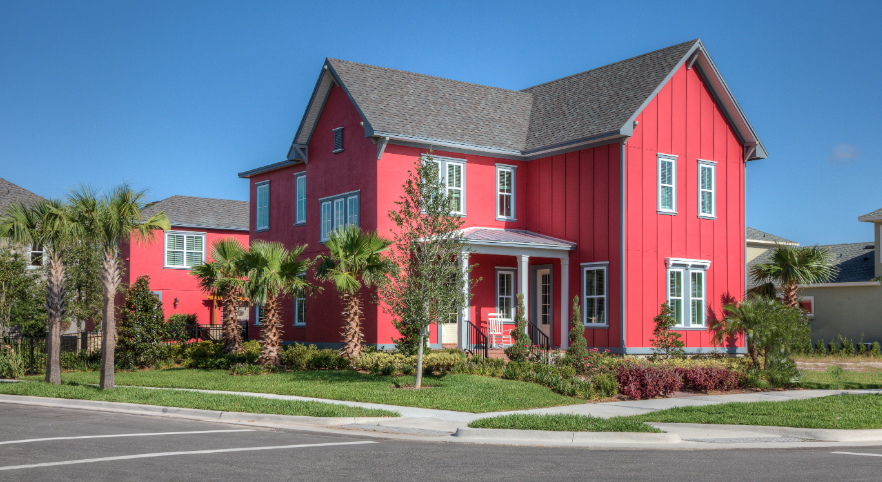
The Anderson model by Ashton Woods is a modern farmhouse that has become an icon for its neighborhood, the Laureate Park master-planned community in Lake Nona, Fla. Photo: Courtesy Ashton Woods
The danger for builders, says architect David Kenoyer, principal at KDK Design Group, who has been designing modern farmhouses for Raleigh’s Triangle area for more than a decade, is focusing on details that are not appropriate for the style. “[Some builders] will focus on their detail page, and the overhangs are the same for all styles whether it’s a farmhouse look or a Queen Anne or a brick box with colonial detailing. It’s not truly farmhouse style; it’s a house [the builder] put details on.”
Farmhouse style exists in all areas of the United States, and it’s important to consider local history and architecture to get it right. Oaks Farms, for example, focuses on the equestrian lifestyle in a region dotted with Spanish and Victorian architecture, Davidson says. Materials, too, depend on regionality. “In the Carolinas and Georgia we may do frame houses; in Florida we use cement block on the floor and wood siding. In Texas we use brick and stone. In Phoenix it’s a stucco-friendly environment, but in each place we can create the look of a modern farmhouse – kind of country meets contemporary,” Kallos says.
Authentic farmhouse style depends mostly on scale. “It's getting your proportions right – the scale of the porches and the fenestration allows the house to speak for itself. That’s the essence of the farmhouse; if you get that right you nail it. When you get it wrong it doesn’t work,” says architect Eric Mandil owner of Mandil Inc., in Denver.
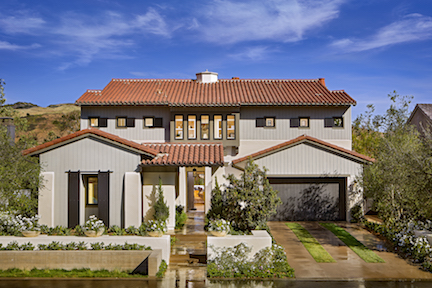
The Residence 2 model at The Oaks Farms, an equestrian community in San Juan Capistrano, Calif., by Davidson Communities, pairs farmhouse rooflines with rustic details and the traditional Spanish-style tile roofing common in southern California. (Photo: Eric Figge)
What's Driving the Modern Farmhouse Trend?
The recession and housing slowdown helped drive the trend, says John Hart, owner of Hart Construction and Development in Chapel Hill, N.C. “That was the end of the McMansion and the opulent excess that drove design. There was a shift back toward simplicity and the art of knowing what to leave out like ornate crowns and multi-layered moldings, heavy trim packages, opulent millwork, curved stairs, and Palladian windows.”
Despite all the talk about simplicity and clean lines, the style is not really a cost saver when it comes to build. Buyers are interested in “authenticity.” In the modern farmhouse, “there’s less detailing, but it’s all real and higher end. There’s no faux. Where there’s a countertop it would be marble. Finishes tend to be authentic because of the market demand,” Davidson says.
Consumers’ interest in saving money on energy costs and the farmhouse’s usually smaller footprint works to their advantage. “[The style] also provides a nice palette for reused and historical materials, which places less demand on new sources of supply,” says Bruce Hammond, CEO of Hammond & Company in Penngrove, Calif., which focuses on sustainable design. “There are a lot of ways for recycled and salvaged materials to be part of this type of building.”
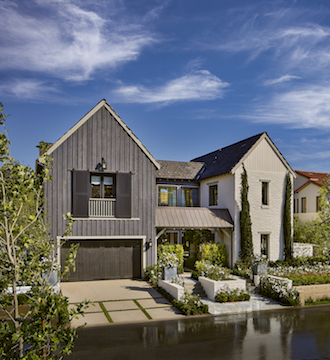
The Oaks Farms' Residence 3 model measures 4,400 square feet, with a tandem three-car garage and five bedrooms. (Photo: Eric Figge)
The desire for modern farmhouse style is also part of a larger cultural movement that includes farm-to-table eating, walkable community living, and a match-up of the home with a more casual family lifestyle.
“Walkability and connectivity [to the outdoors] are not passing references,” says Joan Marcus-Colvin, chief marketing officer of The New Home Company with offices in the Southwest and West. Since traditional farmhouses were open to the land out of necessity (how easy was it to get to the fields and get back for lunch at that big table) the style fits well with today’s homeowners’ desire for access to the outdoors. (AIA’s 2016 Q2 design trend survey shows the continuing importance of outdoor living.) “If we’re not building in areas with [walkability and connectivity] we won’t be successful,” Marcus-Colvin says.
Meredith editor Hart sees via social media that people are gravitating toward nostalgic design, something that speaks to the past. “There’s a real appreciation for that in blogs, on Instagram, Houzz, Pinterest. There’s an appreciation for what has come before, but now it’s being pulled together in a more contemporary format. The farmhouse style is gaining momentum.”
Design: Keeping It Real
With lots of buyers eager for a particular style, production builders run the risk of creating a Disney-like development. David Arkin offers these suggestions for creating a more organic and unique atmosphere.
Have a basic house plan or two and a kit of parts – bays, dormers, sliding shutters, porches – that can be added to address a certain view or solve a particular orientation’s shading needs. This will help ensure that the houses have some variety, and in a way that acknowledges their specific site and climate.
Extend common sense to the landscape to break from a cookie-cutter approach. For example, you’ll often find deciduous trees to the south and coniferous trees to the north and west of a prairie homestead. These were consciously planted to provide shade on summer days, in the afternoon in particular, while welcoming low winter sun and tempering the worst of the winds. Planting in this way, once the trees are established, can also result in substantial energy savings.
Look at vernacular buildings not only for [local] forms, but also clues as to how buildings respond to that particular climate, with strategies for ventilation, shading, wind, and snow shedding. Aiming to slightly modify each home so that it makes sense of its setting and climate will result in a more authentic character.
The farmhouse is an iconic style. “In 10, 20, ... 100 years, it will still be here,” Kenoyer says. “But it won’t be one of those houses [about which] people will say, ‘It’s from the early ’90s with that big arched door and high ceilings.” Mandil agrees. “You don’t want people to say, ‘Oh, the farmhouse? They did that back in ’16.’ [You need to consider] how well do they wear and how trendy will it be?”
Farmhouse Vernacular, Reclaimed Materials
With a very specific equestrian focus, The Oaks is a beach community about 12 miles from San Juan Capistrano. Homes are on 10,000-square-foot lots. To stay consistent with the equestrian ranch theme, lanterns light the streets. There are horse trails and a social barn with a huge fireplace and a platform for people to watch riders in the arena. “We lined up the houses as if we were building on the golf course, but we did this with a horse facility,” says Davidson. “You can look out and see people jumping their beautiful horses."
For the modern farmhouse models, architect John McKee specified reclaimed boards in some of the homes for an authentic look. In the Residence 3 model, the adobe brick on one side ties into the vernacular, but the structure has the forms and the look, with the vertical siding, of farmhouses you might see anywhere in the United States, McKee says. He chose unique finishes that “may be tied to lifestyle and not necessarily the structural style” such as tongue-and-groove wood boards on the ceiling to mimic shiplap. There are exposed rafters and ridge beams since “there’s an honesty that you want to see in farmhouse style.”
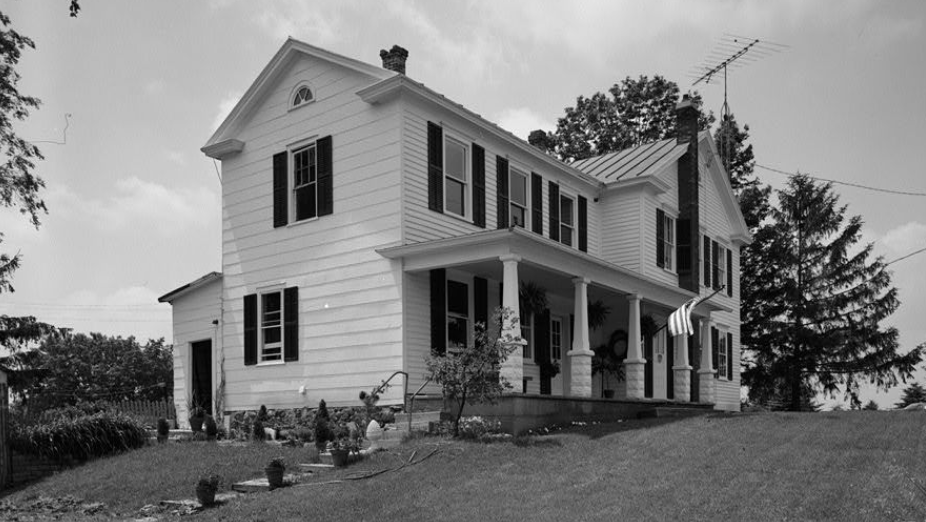
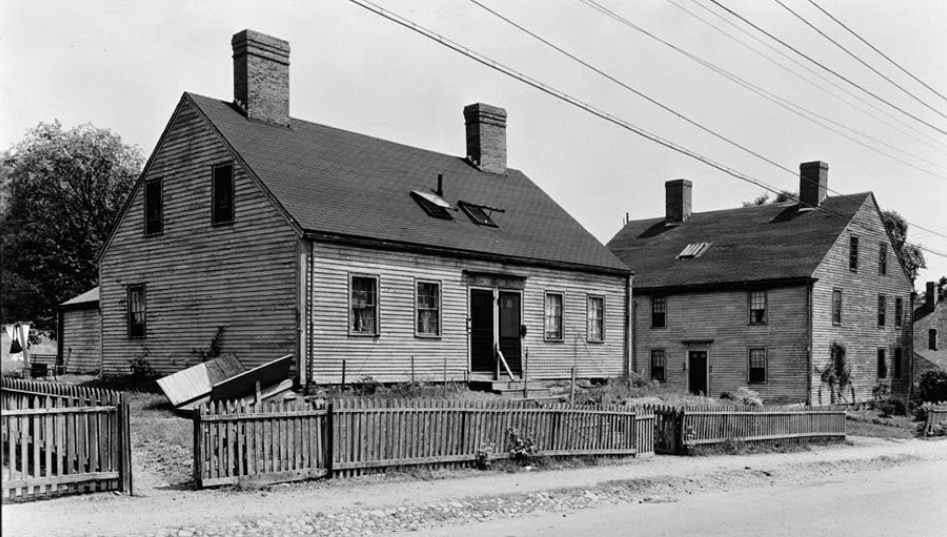
Modern Farmhouse Style: Old Forms Made New
Located in Lake Nona, Fla., Laureate Park is a planned community with homes ranging from 2,705 square feet to more than 3,800 square feet and built in a variety of styles. On their farmhouse-style homes, says Jay Kallos, vice president of architecture, Ashton Woods is using steel columns, Stikwood on accent walls, and exterior paint colors ranging from the traditional grays and beiges with pops of brighter colors to a now-iconic 2,400-square-foot farmhouse known as “Big Red.”
The homes have large kitchens with room for a 10-to-12-seat farmhouse dining table, and vaulted ceilings with exposed trusses. “People are not looking at the farmhouse as value but for what it does to the soul. It’s a comfortable shoe, but you can make it fresh,” Kallos says.
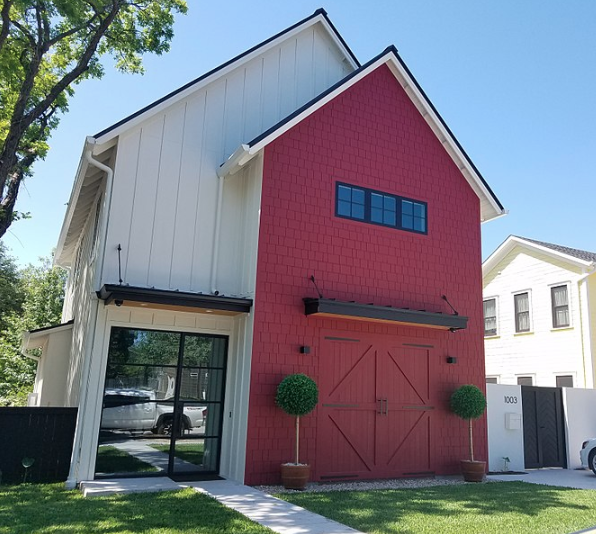
Porch as Focal Point
FrontDoor is the developer and home builder (some lots were sold to Ashton Woods) of this 130-lot waterfront community in Charleston, S.C., on James Island. Using a New Urbanist-style land plan, homes front to a street, are served by an alley, and take advantage of the island’s natural characteristics.
The modern farmhouse “is a popular style that fits the location,” says Mark Lipsmeyer, vice president, FrontDoor South Carolina. “Porches are a minimum of 8 feet deep and oriented to take advantage of breezes, common areas and water.” Homes have detached garages which can be finished.
To create the style, FrontDoor uses a combination of exterior siding—horizontal applications mixed with vertical board and batten and gables. “We'll also give an accent of a ‘reclaimed porch,’ where you take a part of a porch and turn it into conditioned space,” Lipsmeyer says.
Inside, ship lap is used on trim and accent walls and on focal points such as stairwells and fireplace walls. Reclaimed beams are used as fireplace mantles. Standard flooring is hardwood. Interiors are open and barn doors are an upgrade option for flex spaces or master bathrooms. Ceiling treatments like board and batten in the kitchen are popular.
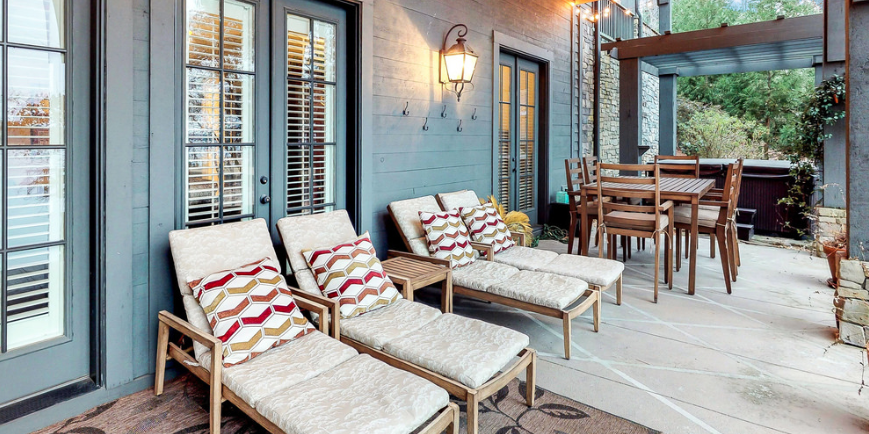
Stacey Freed, a writer in Rochester, N.Y., covers design and building.
Advertisement
Related Stories
Design
2023 BALA Winners: The Best of the Best
You'll find plenty of inspiration in these four award-winning projects from the Best in American Living Awards
Design
What Gen-Z Buyers Really Want in a Home
The fervor of planning for Millennials in the home building industry has now pivoted to Gen Z. So, what does this new generation want?
Design
4 Luxury Production Home Designs to Inspire
Yes, these are designs for production homes, but you won't find any cookie-cutter repetitive elements in this high-end selection


